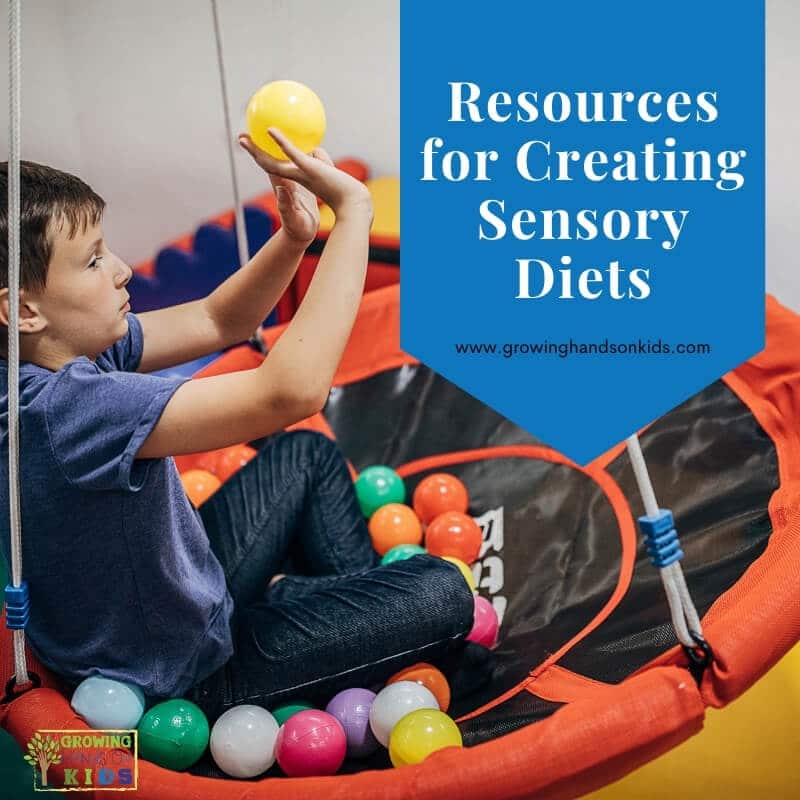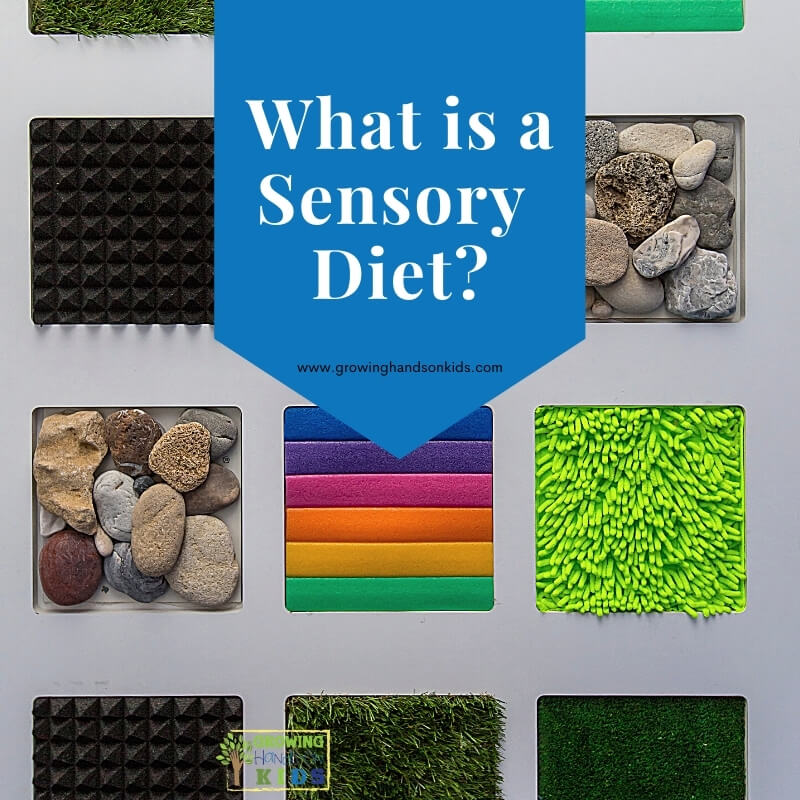Resources for Creating Sensory Diets
Affiliate and Referral links are used below to promote products I love and recommend. I receive a commission on any purchases made through these links. Please see my disclosure policy for more details. As an Amazon Associate, I earn from qualifying purchases.
In the last post, we looked at the basic idea behind what a sensory diet is, who can create one and who they are helpful for. Today I wanted to share some resources for creating sensory diets for therapists, parents, and teachers.
An Occupational Therapist who has been trained in sensory processing and sensory-related therapies is the best person to develop and create a sensory diet for your child. However, all children can benefit from sensory breaks or brain breaks throughout their day.
I am going to share resources for each to help you get started on creating sensory diets in your practice, at home, or in the classroom.
Creating Sensory Diets – for Therapists
Parents and teachers, don't skip this section either. This is good information to know if you are working with a therapist to create a sensory diet for your child.
Typically a therapist will begin by evaluating your child for sensory processing concerns. This is when you need to have very detailed information for the therapist on how your child reacts and responds to different things throughout their day.
The therapist will often do their own observation, as well as give you a sensory screening tool to fill out for your child. All of this information is then put together and the therapist will give their opinion based on all that information.
Once the therapist has an idea of what sensory processing issues your child is facing they can begin to develop strategies and a sensory diet to help your child focus and function throughout the day.
Remember the goal of a sensory diet is to help find that optional level of arousal for your child. So whether your child has a sensory overload or low arousal, there are many different sensory activities that can help.
Vestibular and proprioceptive input is typically the first 2 sensory systems a therapist will address when creating a sensory diet. These two systems are the primary organizers of your child's brain and body. Think big, gross motor movements, lots of pushing, pulling, spinning, bouncing, changing head positions, etc.
Resources for Vestibular and Proprioceptive Input:
- How the Vestibular System Affects Behavior
- 10 Brain Break Activities for Kids
- Sensory Processing – Proprioception – The Inspired Treehouse
- Sensory Processing – The Vestibular System – The Inspired Treehouse
- Sensory Processing Disorder Resources – Mama OT
- Sensory Break Cards for Kids – Sensory Processing Explained
After addressing these two systems, your therapist will look at all the other sensory systems including tactile, auditory, smell and taste, sight, seating, and floor time issues, writing and fine motor skills, meals, and snacks, transitions, etc. All of these may be addressed depending on your child's individual sensory processing difficulties.
Visual schedules for sensory diets are often very helpful. Here are some resources for that.
- Board Maker – Computer software with tons of visual pictures for schedules
- LessonPix.com – Yearly subscription for creating visual schedules, activity cards, etc.
- Sensational Brain – Brain Works
- SticKids
- PECS
- Do2Learn
Creating Sensory Diets – for Parents & Teachers
For parents and teachers, it is important to follow through with all the sensory diet protocols your therapist sets up for you. Carryover into home and school will give you the best outcomes when working with a sensory diet. Consistency is KEY! Without it, you won't know if the sensory diet is really working or not.
It is also important to remember that sensory diets are not a one-time fix-all solution. You will need to work closely with your therapist to continue to tweak and add or take away items from your child's sensory diet until you find the right combination.
Remember that what may work for a couple of weeks may not work after a while. This is why communication with your child's therapist and the teacher is SO important.
Creating a sensory area or room in your home or school is a great way to get started. Having a variety of sensory toys such as fidgets, chewing items, dim lighting, etc. are important parts of a sensory room.
Planning ahead and having an idea of what types of input or transitions set your child's sensory processing behavior off and having ways to help them cope and transition, is important for you to recognize. Having a routine so your child knows what to expect for the day is definitely helpful.
Visual schedules are very helpful for this and here are a few resources for that:
- Free printable daily schedule for kids – And Next Comes L
- Communication Board using the PECS system – By Stephanie Lynn
- Visual Schedule for Special Needs – Sensory Processing Explained
There are so many resources out there that this post could go on and on. But this is a good starting point for creating sensory diets in your home or classroom. Remember to always consult with your therapist when developing and creating sensory diets.
Also, remember that all kids need sensory breaks, many of these resources will be helpful for including those in your child's day.
For more reading on sensory processing and how you can help any child, here is a list of books I recommend.
The Sensory Lifestyle Handbook: How to Create Meaningful and Motivating Sensory Enrichment for Sensory-Filled DaysRaising a Sensory Smart Child: The Definitive Handbook for Helping Your Child with Sensory Processing Issues, Revised EditionThe Out-of-Sync Child: Recognizing and Coping with Sensory Processing Disorder (The Out-of-Sync Child Series)The Out-of-Sync Child Grows Up: Coping with Sensory Processing Disorder in the Adolescent and Young Adult Years (The Out-of-Sync Child Series)Sensational Kids: Hope and Help for Children with Sensory Processing Disorder (SPD)Sensory Processing 101
You can also follow my Occupational Therapy Tips board for more OT-related advice and articles.
You May Also Like:

Heather Greutman, COTA
Heather Greutman is a Certified Occupational Therapy Assistant with experience in school-based OT services for preschool through high school. She uses her background to share child development tips, tools, and strategies for parents, educators, and therapists. She is the author of many ebooks including The Basics of Fine Motor Skills, and Basics of Pre-Writing Skills, and co-author of Sensory Processing Explained: A Handbook for Parents and Educators.












What a great list of resources! I will bookmark for use in my child therapy practice. Thanks!!
Wonderful Natasha, glad it was helpful for you!
This is very helpful – I hadn’t heard of a “sensory diet” before. I just wish all teachers were more open to the idea!
Thanks Emma. Yes, everyone needs to be on board for sensory diets to really work.